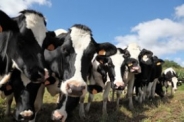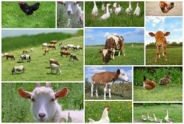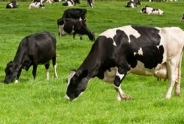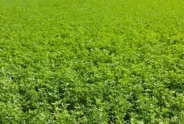Grains
 Soybean acreage continues to rise in New York. Farmers harvested a record high 312,000 acres in 2012 (USDA & NASS, New York Field Office). Good soils and favorable August weather have been good for grain yields. NY farmers have averaged 46 bushels over the past 3 seasons. This is very comparable to soybean yields in the Midwest. Maturity groups 0-3 can be grown successfully in NY. The majority of the soybeans are grown in the Finger Lakes and into Western NY but are beginning to expand eastward. Cayuga County is the top soybean producing county followed by Seneca, Ontario, and Wayne.
Soybean acreage continues to rise in New York. Farmers harvested a record high 312,000 acres in 2012 (USDA & NASS, New York Field Office). Good soils and favorable August weather have been good for grain yields. NY farmers have averaged 46 bushels over the past 3 seasons. This is very comparable to soybean yields in the Midwest. Maturity groups 0-3 can be grown successfully in NY. The majority of the soybeans are grown in the Finger Lakes and into Western NY but are beginning to expand eastward. Cayuga County is the top soybean producing county followed by Seneca, Ontario, and Wayne.Winter wheat is an important cash crop in New York not only for the grain but also its straw value. Both soft red and white varieties are grown in NY. Wheat flour is used in pastries, crackers, cookies, and breakfast cereals. Wheat also plays an important role in maintaining crop diversity and rotation. Growers harvest about 100,000 acres of wheat each year in NY and have averaged 63 bushels per acre over the past 5 seasons (USDA & NASS, New York Field Office). The majority of the winter wheat is grown in western NY with Livingston, Monroe, and Genesee as the top 3 producing counties.
Corn for grain and silage is a very important feed source for New York's dairy and livestock industry. In 2012, 680,000 acres of corn for grain and 475,000 acres of corn silage were harvested by NY growers (USDA & NASS, New York Field Office). Cash grain operators rotate corn annually with soybeans and small grains while more continuous and longer rotation corn is grown on the dairies for silage. NY corn producers have averaged 139 bushels of grain and 17 tons of silage over the past three seasons. Cayuga, Livingston, and Wyoming are the top corn producing counties in NY.
Oats are a versatile crop that is the first grain crop planted in the spring. Other than grain for feed, they are also grown for straw, silage, cover crop, emergency forage, and a nurse crop in alfalfa seedings. About 60,000 acres of oats are planted each year and the majority goes to grain. Statewide grain yields are very similar to wheat around 65 bushels per acre. Spring barley can be planted as an alternative for oats. Barley yields less than oats (50 bushels per acre) but has a higher feed energy similar to corn. Only about 10,000 acres of spring barley are planted each year
Farm Financial Management Practices for Unfavorable Economic Conditions
Sound financial planning and control improve owner's abilities to manage their businesses during unfavorable economic conditions. Consider the current environment affected by the COVID-19 pandemic, and the lack of rain in many areas. Budgeting is a valuable farm financial management practice for these situations. Visit (Brandie, please insert link here) to learn more about budgeting and its value in managing your farm business.
Pricing Corn Silage -- Fall 2019
John Hanchar, Farm Business Management Specialist
Northwest New York Dairy, Livestock & Field Crops
- Analysis suggests corn silage price depends on corn silage quantities, alfalfa hay price, the price received by farmers for milk, and corn grain price.
- Analysis for NY suggests that estimated corn silage price is most sensitive to corn silage quantities, alfalfa hay price and corn grain price.
- Price estimates combined with understanding of relevant supply and demand factors from an individual farm business owner's perspective can aid decision making regarding corn silage price. Given recently available alfalfa hay and corn grain prices (May through July, 2019, and August 27, 2019, respectively), price analysis for NY suggests an estimated corn silage price of about $45 per ton. The Fall 2018 estimate was about $41 per ton.
Webinar for Dairy Producers will Cover New Dairy Margin Coverage Program
John Hanchar, Farm Business Management Specialist
Northwest New York Dairy, Livestock & Field Crops
The USDA/Farm Service Agency in New York is partnering with the NYS Crop Insurance Education Program to present a webinar for dairy producers.
Economics of Producing Industrial Hemp in NYS, 2019 Budgets
John Hanchar, Farm Business Management Specialist
Northwest New York Dairy, Livestock & Field Crops
Farm business owners can use 2019 budgets to make decisions regarding industrial hemp's place in their cropping systems.
Malting Barley Budgets, New York, 2019
John Hanchar, Farm Business Management Specialist
Northwest New York Dairy, Livestock & Field Crops

Farm business owners can use the 2019 revenue, costs and returns estimates from the budgets to make decisions regarding malting barley's place in their cropping systems.
Crop Alert
Mike Stanyard, Field Crops & IPM Specialist
Northwest New York Dairy, Livestock & Field Crops

Timely observations, information, and control strategies for managing pests, fertility, and current conditions on northwestern NY farms.
Malting Barley Budgets, New York, 2018
John Hanchar, Farm Business Management Specialist
Northwest New York Dairy, Livestock & Field Crops
Farm business owners can use the 2018 cost, revenue and return estimates from the budgets to make decisions regarding malting barley's place in their cropping systems.
Transitioning from Conventional to Organic Production for the CSW Rotation
John Hanchar, Farm Business Management Specialist
Northwest New York Dairy, Livestock & Field Crops

Growers transitioning from conventional to organic production for the corn, soybean, wheat (CSW) cropping system can use an analysis of transition period economics to make decisions regarding an optimal crop sequencing.
Estimated cost of production, conventionally tilled malting barley
John Hanchar, Farm Business Management Specialist
Northwest New York Dairy, Livestock & Field Crops
Producers can use cost and returns estimates to make decisions regarding malting barley production's place in their cropping systems: understanding variability plays an important role.
Malting Barley Budgets, Conventional Tillage, New York, 2017
John Hanchar, Farm Business Management Specialist
Northwest New York Dairy, Livestock & Field Crops
Producers can use cost and return estimates to make decisions regarding malting barley production's place in their cropping systems; understanding variability plays an important role.
Malting Barley Budgets, Reduced Tillage, New York, 2017
John Hanchar, Farm Business Management Specialist
Northwest New York Dairy, Livestock & Field Crops
Producers can use cost and return estimates to make decisions regarding malting barley production's place in their cropping systems; understanding variability plays an important role.
Benefits and Costs of Entry Level Precision Agriculture Technologies
John Hanchar, Farm Business Management Specialist
Northwest New York Dairy, Livestock & Field Crops

Auto Section Control (ASC) is a precision agriculture technology designed to reduce double planting and other crop input usage in headlands. See the presentation by Erick Haas and John Hanchar at the 2017 Operations Managers Conference for benefits and costs, including results from partial budgeting and capital investment analysis.
Upcoming Events
2026 Corn Congress
January 14, 2026
Henrietta, NY
Participant Registration for the 2026 Corn Congress NOW OPEN!
NOW OFFERING 1.5 DEC Recertification CREDITS
2026 Forage Congress
January 28, 2026
Nunda, NY
More info to come





